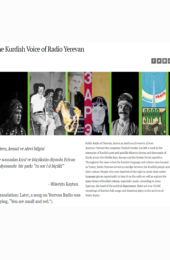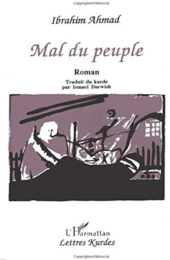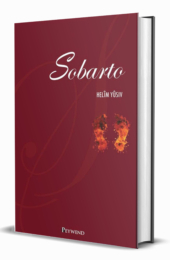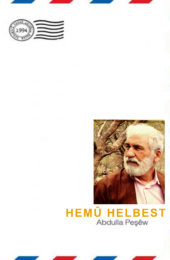The Kurdish Voice of Radio Yerevan
Public Radio of Yerevan, known as Radyoya Erîvané or Erivan Radyosu* beyond the Armenian-Turkish border, has left a mark in the memories of Kurdish poet and guerilla Hüseyin Kaytan and thousands of Kurds across the Middle East, Europe and the former Soviet republics. Throughout the years when the Kurdish language and culture were banned in Turkey, Radio Yerevan served as a bridge between the Kurdish people and their culture. People who were deprived of the right to study their native language got an opportunity to hear it on the radio as well as explore the many layers of Kurdish culture, especially music. According to Artur Ispiryan, the head of the archival department, there are over 10,000 recordings of Kurdish folk songs and theatrical plays in the archives of Public Radio.
Riya Teze (rojname)
Rya Teze ('New Path'), formerly written as Rja Ţəzə and Р’йа т'әзә (in Cyrillic script), was a Kurdish language newspaper published from Yerevan, Armenia.[1][2] The newspaper was founded in March 1930 and the first issue was published on 25th March 1930, printed in Kurmanji Kurdish with the newly latinised alphabet of Shemo-Margulov.[2][3][4] It was the organ of the Kurdish section of the Communist Party of Armenia,[1] and was produced under the auspices of the Central Committee of the Communist Party of Armenia and the Supreme Council and the Council of Ministers of the Armenian SSR. At the time, it was a four-page newspaper, published twice every week and with a circulation of 600 copies.[4] Prior to the Kurdish linguist and author Cerdoyê Genco taking over as editor in 1934, the newspaper was run by three Armenians born in Western Armenia: Kevork Paris, Hrachya Kochar and Harutyun Mkrtchyan, who knew Kurdish.[4][5] Publication was discontinued in 1937.[2]
In 1955 publication of Rya Teze (in Cyrillic script) was resumed with Miroyi Asad as its editor.[2][6] As of the early 1970s it was published semiweekly and had a circulation of 2,800.[6] By 1976 circulation reached 5,000.[3]
As of the 1980s Rya Teze had a weekly circulation of 4,000 and was read by Kurds across the Soviet Union;[2] a smaller number of readers existed among the Kurds in Europe, who sometimes adopted material from it in their own publications published in Germany and Sweden.[7] In 1989 Tital Muradov took over as editor, and in 1991 the editorship was handed over to Emirike Serdar.[2]
Following the disintegration of the Soviet Union the newspaper faced financial difficulties as it no longer received state support. It survived, however. It was converted into a monthly with a circulation of five hundred. In 2000 the script was changed back to Latin alphabet.[2] The newspaper was shut down in 2003 due to economic problems. All in all 4,800 issues of Rya Teze were published between 1930 and 2003.[2]
Director: Rezan MAD: Riya Teze
Nûbihar
Nûbihar also known as Kent Işıkları (Kurdish: Weşanxane Nûbihar, Turkish: Nubihar Yayınları) is an academic publisher founded in March 1992 in Istanbul, Turkey. The publishing house specialises on topics pertaining to Kurds.[1]
The publication is named after a work of Ehmedê Xanî.[2]
History
Nûbihar was founded as a Nursi-influenced publication house just after the ban on the Kurdish was lifted. Even though it was legal to publish in Kurdish, its work remained a high-risk activity as local officials were ready to stifle Kurdish cultural activities by any chance. Nonetheless, Nûbihar survived any closure arguably because its publications were of religious and cultural nature and not political.[3] During this period, the publication was accused of being Kurdist by the Gülen movement after the former had criticised the censorship of words like "Kurds" and "Kurdistan" in their publications of the works of Said Nursî.[4]
Director: Suleyman Cevik
Gelawêj
Evil of the people
The evil of the people is the suffering, the hope of an entire
people: the Kurds.
Suffering equal to that of the young and beautiful Kalée,
alone, about to give birth. Hope equal to that of Jwamer,
who was sent to prison for ten years by fate because
he found himself, by chance, at the head of a demonstration.
Evil of the people is a torn Kurdistan, with a feeling
of survival of the things of the earth and the soul. He
denounces the attacks on human dignity of which different
regimes and their prisons remain forever guilty.
Despite this, the book remains a novel. Ibrahim Ahmad
incorporates elements that are non-fictional in nature into
stories that remain captivating for the imagination and
sensitivity; his heroes experience the illumination of
the “feeling of existence”.
Ibrahim Ahmad is not only a femon, but also an actor,
sometimes hidden, sometimes discovered, in the great dramas
in Kurdistan,
Ibrahim AHMAD. Born in 1913 in Soulémani, Iraqi
Kurdistan. Founder of the famous linear magazine Gelawej (1939-1949),
he participated in the development of Kurdish literature.
Novelist, poet but also short story writer, Ahmad is considered the
representative of the realistic movement in contemporary Kurdish
literature.
Ismael DARWISH. Born in 1961 in Kirkuk, Kurdistan.
Iraqi. Among the unpublished texts of contemporary Kurdish literature,
he translated a collection of poems and several Kurdish short
stories.
Work translated with the assistance of the Cenure National du Livre.
Director: Ibrahim Ahmed
Hawar
Hawar (meaning The Cry in English) was a Kurdish literature magazine, which was published in Damascus between 1932 and 1943.[1] The magazine was first issued by Celadet Alî Bedirxan[1] on 15 May 1932. The magazine was the first Kurdish literary magazine in Syria[2] and it was intended to publish it on a monthly basis,[2] but its publication was interrupted several times. The first 23 issues were published between 15 May 1932 and the 27 September 1935.[3] The issues number 24 - 26 appeared between 1 April 1934 and 18 August 1935.[3] The remainder was published between April 1941 and August 1943,[3] and the French, who governed Syria and Lebanon at the time, supported its publication.[4] The 57th and last issue was released on 15 August 1943.[5] The first 23 issues of the magazine were published in both the Latin and the Arabic alphabets, but from the 24th issue onward, only the Latin alphabet was used.[3] The Kurdish alphabet, which was formulated by the publisher Celadet Alî Bedirxan and also referred to as Hawar alphabet or the Bedirxan alphabet, was used to publish Hawar.[6] The texts which were published emphasized the value of the Kurdish folklore for developing the Kurdish language and personal qualities.[7] Hawar had its most subscribers in Syria and Iraq, but also Lebanon, Iran. Some educational institutions and libraries in Europe and the Middle East also subscribed to the Hawar magazine.[8] Since 2006, the 15 May, the date of the first publication of Hawar in 1932, is celebrated as the Kurdish language day.[9][10]
Celadet Alî Bedirxan said of his purpose for the magazine: "Hawar is the voice of knowledge. Knowledge leads to personal reflection. A person who becomes aware of the inner-self desires freedom and happiness. Self-knowledge also leads to self-expression. This magazine will reflect those expressions in the Kurdish language".[2]
Director: Celadet Ali Bedirxan
Peşiyan 101 çirok, Çiroken Efsaneyen Kurdî, 101 BiwêjÇîrok
"Peşiyan 101 çirok, Çiroken Efsaneyen Kurdî, 101 Biwêj Çîrok Mehmet Öncü"
- Peşiyan 101 çirok is a Kurdish book written by Mehmet Öncü. It contains 101 stories, reflecting the richness of Kurdish language and culture .
- Çiroken Efsaneyen Kurdî is another work by Mehmet Öncü, showcasing Kurdish legends and myths .
- 101 Biwêj Çîrok is a separate publication, offering a diverse collection of stories, including border tales and narratives from Kurdish literature .
These works contribute significantly to the preservation and promotion of Kurdish language and storytelling traditions. Mehmet Öncü's writings provide readers with insights into the cultural tapestry and linguistic nuances of the Kurdish people.
Director: Mehmet Öncü
Sobarto
Sobarto Helîm Yûsiv is a Kurdish author known for his literary works, including the novel "Sobarto" (Avesta/Roman) published in 1999 .
Yûsiv has authored several books, "Sobarto" is available in Kurdish and Arabic, reflecting Yûsiv's cultural and linguistic diversity .Widely recognized for his literary prowess, Yûsiv's works, including "Sobarto," have garnered positive reviews . Sobarto Helîm Yûsiv's impact extends beyond his novels, contributing significantly to Kurdish literature .
Director: Helîm Yûsiv
Hemû helbest
Abdullah Peşêw, a Kurdish poet: Abdullah Peşêw is a prominent Kurdish poet, born in 1946 in Hewlêr. He has been actively writing poetry for over 40 years, with eight published divans. His work is celebrated for its depth and cultural significance within the Kurdish literary landscape. His poetry collection, titled "Hemû Helbestên 'Ebdulla Peşêw'," showcases his comprehensive body of work.
Notable Works: Peşêw's notable works include the poetic series "Berg 1, 2, 3". One of his poems, "Qehpe ne," is available on YouTube, reflecting his poetic mastery.
Literary Impact: Recognized as a key figure in Kurdish literature, Peşêw's contributions have left a lasting impact, and his book "Abdulla Peşêw Rizgarkerê Dawî yê Helbesta" attests to his influence.
In summary, Abdullah Peşêw is a revered Kurdish poet with a substantial literary legacy, evident in his extensive body of work and lasting cultural impact.
Director: Abdullah Peşêw







